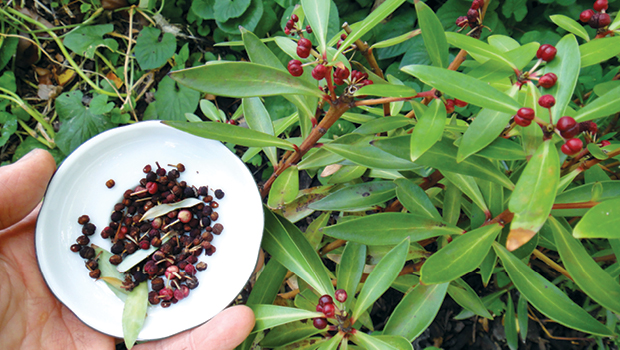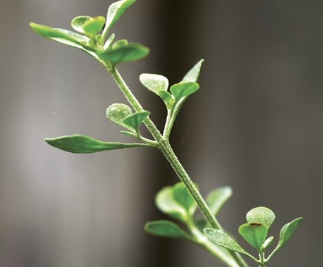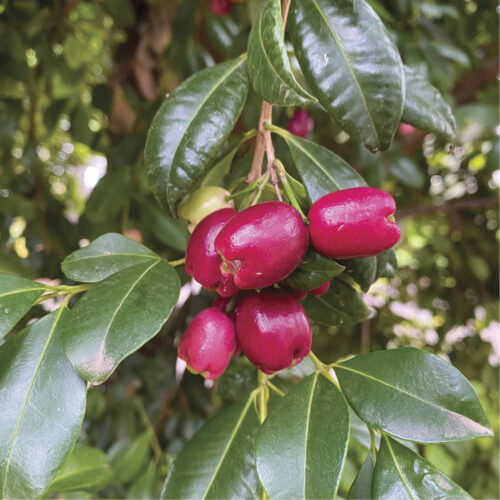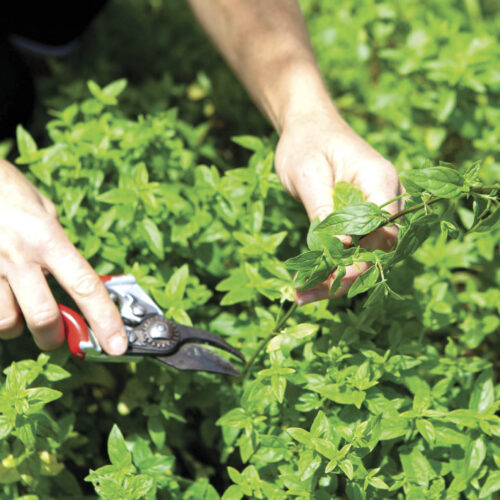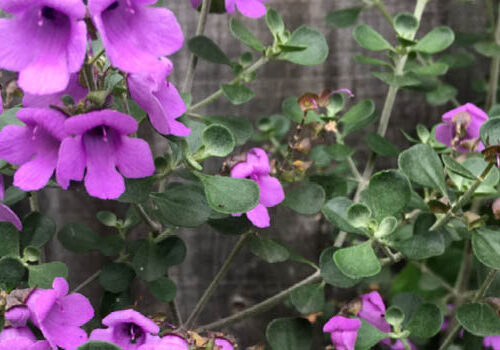Discovering native herbs
2017-04-03T02:11:17+10:00
Karen Sutherland investigates the unique flavours and aromas of many little-known native herbs.
Native Australian plants have been used for centuries by Aboriginal people for food, medicine, tools and shelter. While some traditional uses have been documented, sadly much ancient knowledge has been lost along with its holders. Luckily, there are still Aboriginal people around with knowledge, bolstered by the work of ethnobotanists who have researched and recorded the traditional uses of indigenous plants.
Although edible native plants have been mostly ignored by mainstream Australia, the native food industry is beginning to flourish, as chefs and foodies alike discover what is on offer and how to use the produce.
Similar to their European counterparts, native herbs can be used as medicine or food – here we focus on the latter. There are an amazing variety of Australian herbs that are easily grown in pots or gardens, full sun or semi shade. Native varieties offer tastes and aromas unlike any other and can be used fresh or dried, in teas, drinks, baking and a range of sweet and savoury dishes.
Provenance is important when sourcing native herbs. It relates to where a plant comes from and will determine the levels of essential oils in plant cells and the flavour. Provenance can also determine climatic tolerance, so that some lemon myrtles may be naturally more cold tolerant than others due to the microclimate in which they occur. It is good to check provenance when buying plants.
To avoid depleting our natural landscapes, it’s always better to buy plants from reputable nurseries and grow your own rather than wild harvest. If you do choose the latter, you must ensure correct identification.
The native herbs I’ve chosen to feature can be grown in pots, making them suitable for most gardens. Herbs with leathery leaves, such as native pepper and lemon myrtle need to be picked when the leaves are fully mature so their leaf structures, flavour and aroma profiles are sufficiently developed.
For the home gardener and cook, many native herbs are still difficult to source as only a small number of nurseries have embraced them. Here, then, are some of the more readily available ones to start with.
Lemon myrtle
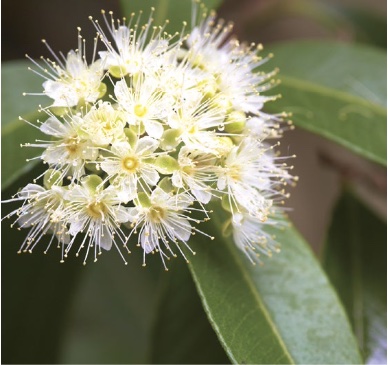
Perhaps the best-known Australian herb, lemon myrtle (Backhousia citriodora) is a large shrub or small tree from coastal rainforest areas of Queensland, growing up to
8m tall x 3m wide in its native state. As a rainforest plant it prefers humidity and enjoys shade, or at least some protection from cold wind, making it a suitable understorey plant. It can do well as far south as Melbourne, growing 3m tall x 1.5 m wide in 20 years. In cooler climates it makes a great potted plant on a shady verandah, easily kept to 1.5m tall x 0.5m wide by regular harvesting.
Leaves have a strong lemony aroma and taste, with a hint of the spiciness of lemongrass, and should be harvested when fully mature. One leaf crumpled in a cup of boiling water makes a delicious drink or you can add several to a pot of black tea. Iced lemon myrtle tea is a refreshing summer beverage, as is a cordial made from the leaf infusion.
Dried and ground leaves can be sprinkled over fish fillets when cooking or added to biscuits, cakes and desserts, while whole leaves can be added to curries.
Native pepper (main image)
Native pepper (Tasmannia lanceolata), also known as pepperberry, has spicy leaves and berries for culinary use. Native peppers are dioecious, which means that both male and female plants are needed for berries to be produced and harvested. You’ll need to wait 3–5 years for your first harvest though. Native to temperate rainforests of Tasmania, Victoria and NSW, plants vary between 0.5m and 4m in height, depending on their provenance, and thrive in rich, well-drained soil. They need some shade and will perish if allowed to dry out. Harvest mature leaves for drying and grinding, and enjoy the dull-green powder used as you would any ground pepper. Fresh pepperberries are best crushed in a mortar and pestle when they are still quite soft, although older, drier fruit will pass through a pepper grinder.
Native sage
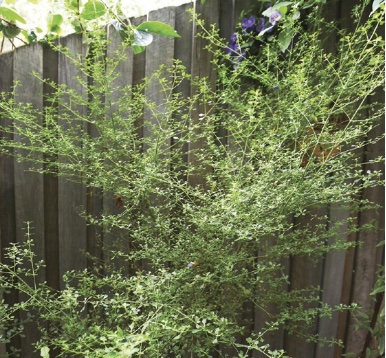
Native sage (Prostanthera incisa) is a smaller plant than native thyme, growing to approximately 1.5m high and wide but has similar uses, such as an ingredient in mint sauce (native thyme and sage have strong menthol content and are sometimes labelled as mint bushes). Native sage seems to appeal to people more because of its smaller leaves and slightly softer flavour. Plants occur mostly in eucalypt forests along the east coast of NSW. Both native sage and thyme can usually be found at native nurseries.
Native thyme
Native thyme (Prostanthera rotundifolia), an evergreen shrub up to 2m high and 1.5m wide, is found in temperate regions of Tasmania, Victoria, NSW and South Australia. Similar to native sage, it’s a fast-growing understorey plant with bright-purple flowers in spring that enjoys some shade and moisture. Finely chopped fresh leaves, with stems removed first, make a fabulous herb butter, great for melting over vegetables and meat alike. Leaves can be used fresh or dried and their strong flavour pair well with meat or eggplant dishes, as a marinade or added during cooking.
Native mint
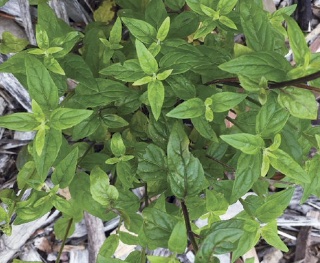
Native mint (Mentha australis) or river mint, is widespread near waterways in all eastern states and Tasmania and has an incredibly variable aroma and flavour. In my experience, three different indigenous nurseries from Melbourne have yielded three plants with very different aroma profiles.
Native mint copes with much less watering than European mints and prefers more sun. It’s deciduous in winter but should only be cut back by half at this time – cutting to ground level will kill it.
Native mint has delicate leaves with surprisingly strong aromas. Aboriginals crush a handful of leaves to inhale to clear a stuffy nose. The leaves can be used whole or chopped in savoury dishes such as tabbouleh or salsa, or thrown over chopped watermelon or pineapple. Native mint combines well with chocolate and enlivens cocktails that would normally use European mint.
Strawberry gum
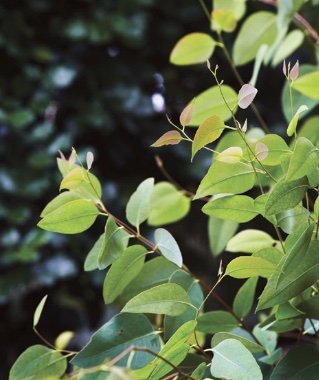
Strawberry gum (Eucalyptus olida) is a medium-sized tree (to 20m) that occurs naturally in an isolated pocket of northern NSW, but can grow to about half its height in cooler regions such as Victoria, where frost protection is likely needed in the first year or two after planting.
In cooler regions, strawberry gums can be trained into an attractive small tree, or kept as a shrub by allowing branches to grow from the base and pruning to keep bushy. Try to prune when a new growth flush has matured, as strawberry gum leaves need to be harvested when fully mature.
Use one crumpled fresh leaf to make a cup of tea or add a few to a pot of black tea. Leaves can be added to stewed fruit while cooking for a lovely berry flavour. Dried and ground leaves make an aromatic green powder for use in baking.
Lemon tea-tree
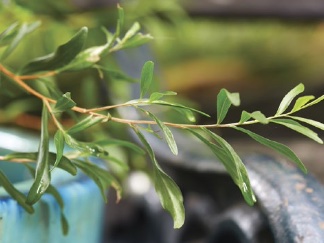
Lemon tea-tree (Leptospermum petersonii) is an easily grown shrub. Useful in the garden for screening, it grows up to 4–5 m tall with a gently weeping habit. Crush a sprig of leaves and rub them over your skin as a homemade mosquito repellent – it contains citronellal, which gives the aroma and insect-repellent characteristics to citronella oil. Tea-trees gained their common name from early European settlers who used the leaves to make tea. A sprig of leaves makes
a refreshing lemon infusion, although it should perhaps be consumed irregularly due to the citronella content.
Sourcing native herbs
Look for specialist native nurseries or others that carry a good range of natives. Here are some suggestions:
Victoria
St Kilda Indigenous Nursery Cooperative
New South Wales
Muru Mittigar Provenance Nursery
Queensland
Tasmania
South Australia
Australian Arid Lands Botanic Garden Port Augusta
Western Australia
For the full story on native herbs, including detailed growing advice and tips on how to use native thyme, sage, pepper, mint and lemon myrtle, get your copy of Organic Gardener Issue 94.

